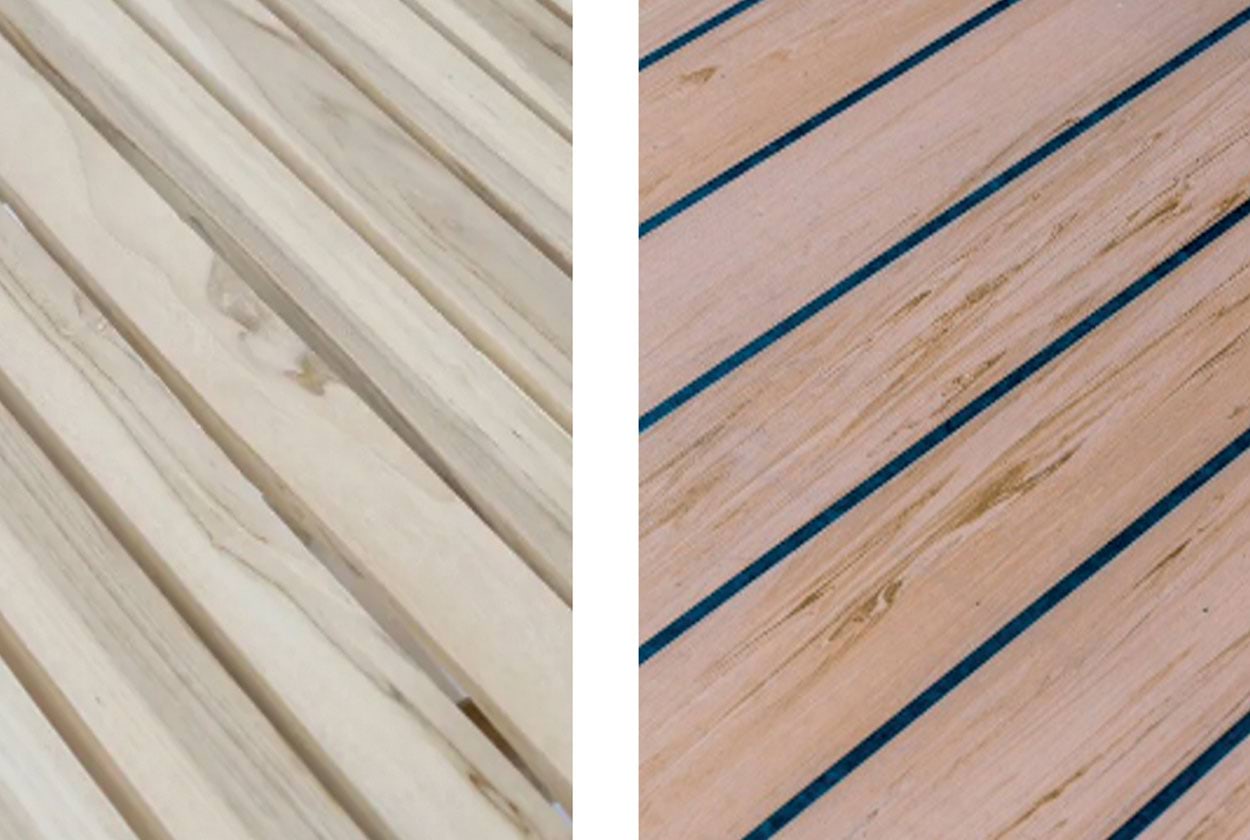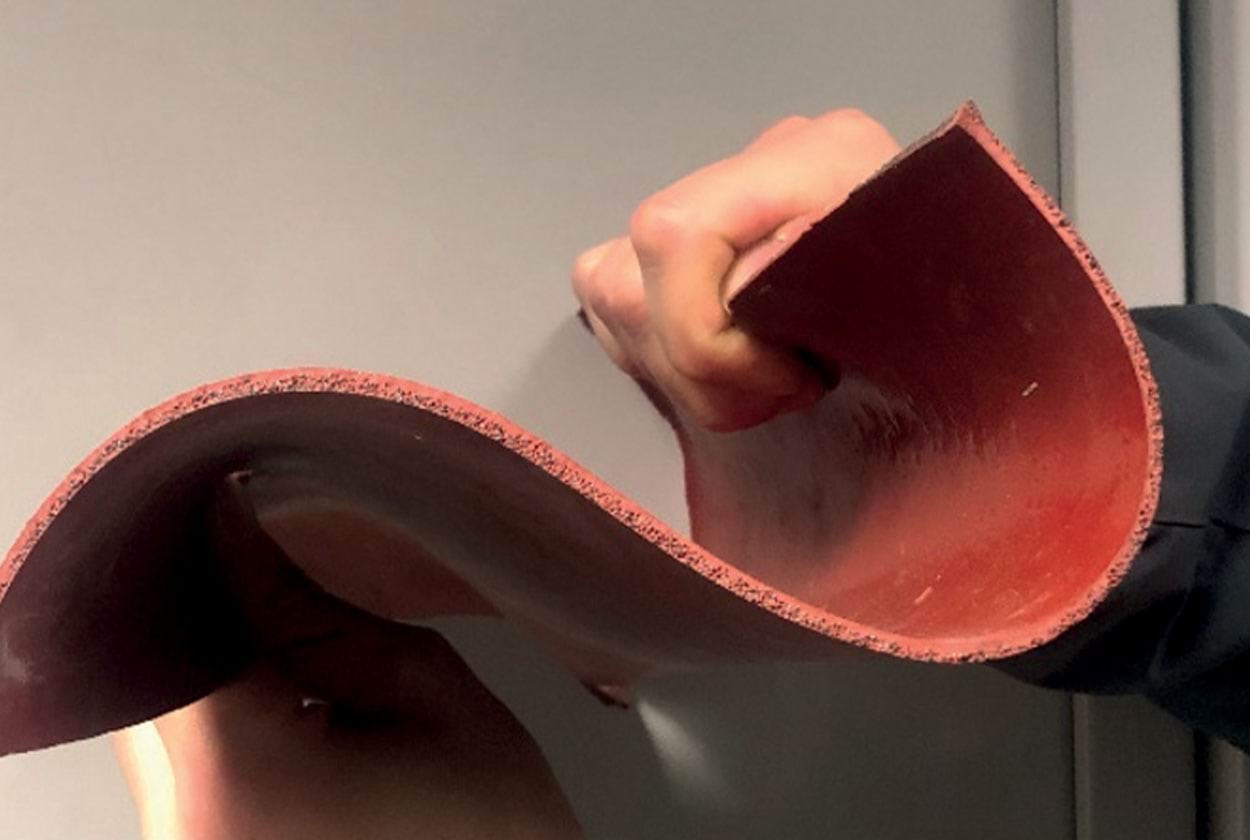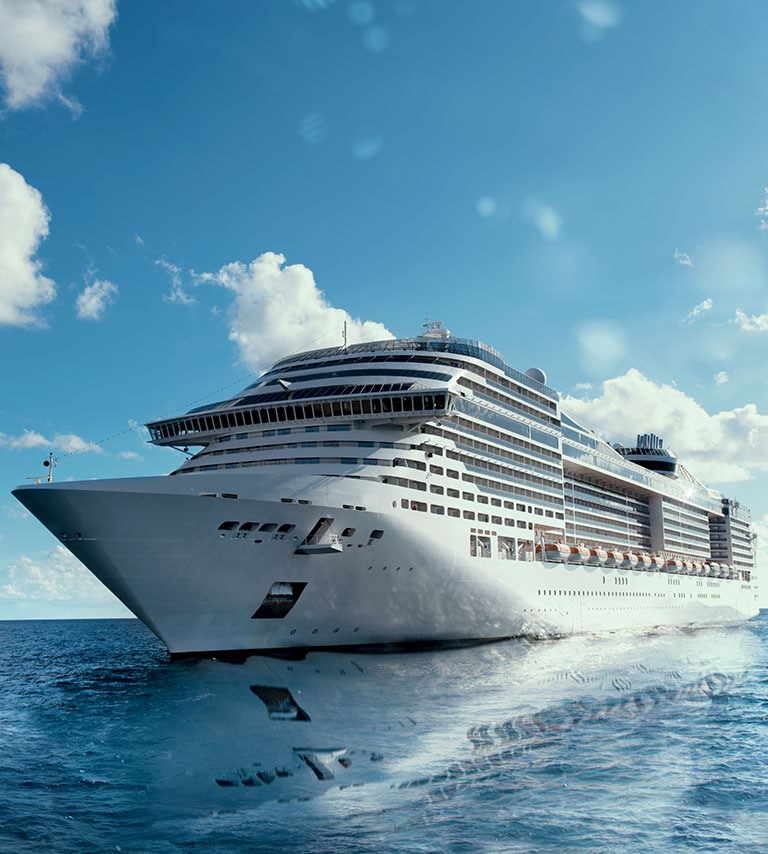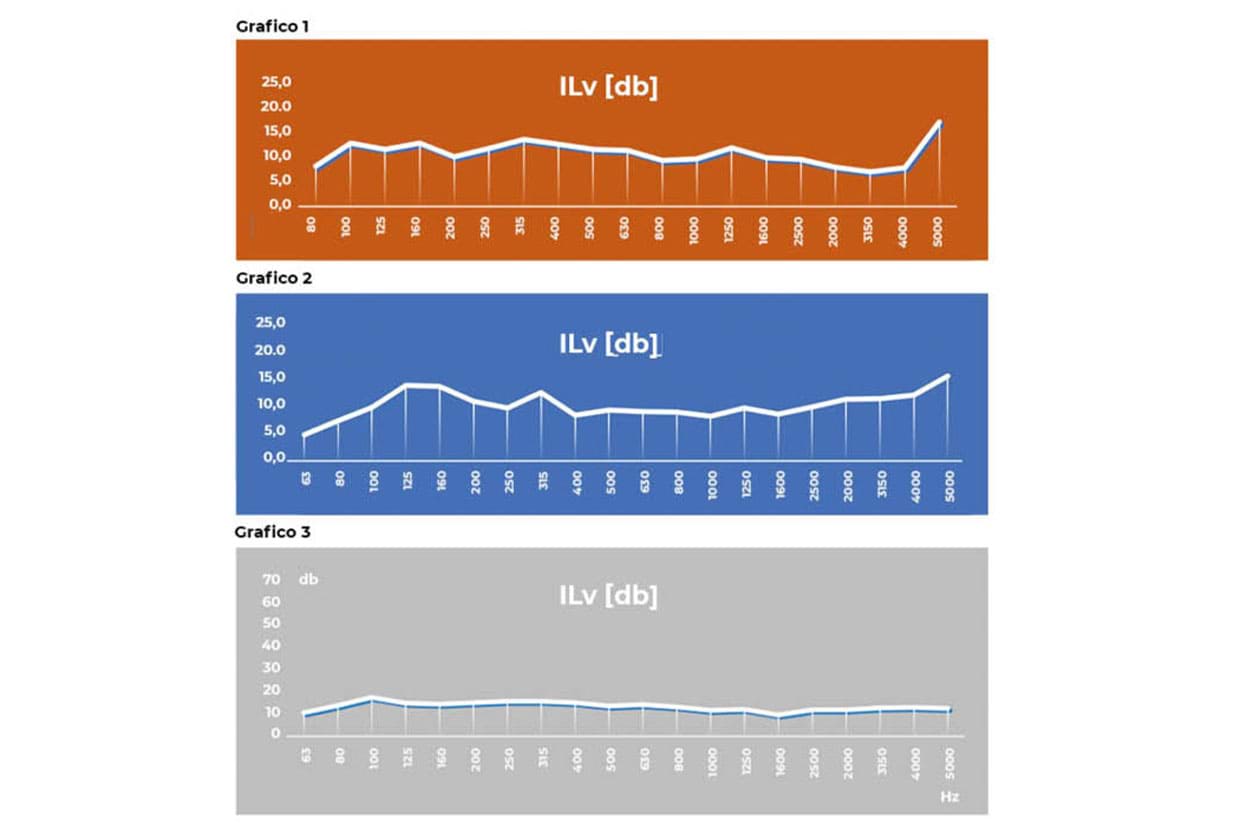Andrea Gerardini
CEO & Sales Director, Mapei Marine (Mapei Group)
Mapei marine developed new solutions for the needs of the shipbuilding industry
Even though the ship-building industry replaced natural teak with synthetic teak to cover external decks on boats and ships a number of years ago, those who love sailing still enjoy the pleasure of seeing wooden decks. This is why the demand for aesthetic finishes similar to wood has driven various producers of resin systems to propose synthetic teak coverings that look just like natural wood. Over the years these aesthetic effects have progressively improved.
The natural veining of wood, or rather its “wood grain” effect, is determined by the conformation of the rings in the trunks of trees. These rings are generated during a tree’s growth due to the continuous oscillations of the trunk caused by the wind. What a human eye perceives when a trunk is cut and processed is an optical effect determined by the very nature of the veining, which is often three-dimensional. And this explains the complexity in reproducing the grain effect of natural wood in a self-levelling resin system.
Mapedeck Teak Evolution for Costa Crociere
The producers of resin systems are striving to meet the demand from the maritime industry to improve the aesthetic quality of synthetic teak, and this has also become an objective for Mapei Marine, the Mapei Group’s product line providing solutions for the ship-building industry.
To obtain the desired result an existing base product, MAPEDECK TEAK DESIGN, had to be modified by altering some of its mechanical characteristics without precluding the possibility of creating various chromatic effects and, at the same time, making it possible to obtain a wood grain effect in the product while still fluid.
The critical issues that needed to be overcome regarded the stabilisation of the system, which consists of a monochrome base layer and veining in a contrasting colour created in the base layer.
The grain effect had to remain until the product had fully hardened, without deforming and/or without being absorbed in the fluid mass, and then disappearing or forming a series of shapeless blotches or streaks of various sizes. In order to create the veining manually, special steel “rakes” with adjustable blades were used.

On the left: natural teak. Right: the aesthetic effect of MAPEDEK TEAK EVOLUTION.
The final result can be seen in the photos of the external deck of the Costa Pacifica, a cruise liner owned by the Genoa-based cruise ship company Costa Crociere. The photos show the “aesthetic” quality achieved.
The application phases may be summarised as follows:
- application of a layer of monochrome MAPEDECK TEAK EVOLUTION around 3 mm thick with a notched trowel;
- while this layer was still fluid, workers wearing special hobnail boots and pushing a special trolley with notched wheels applied MAPEDECK TEAK EVOLUTION on the surface in a contrasting colour to the monochrome base coat. Then, with the special steel rake, the veining was created.
This standardised application process for the MAPEDECK TEAK EVOLUTION system enables particularly high quality aesthetic effects to be created through a series of simple, repeatable actions, which can be carried out by installers used to applying resin systems, without requiring a particularly high level of expertise, dexterity or practical experience.

MAPEDECK TEAK EVOLUTION was used on the deck of Costa Pacifica cruise liner to combine the performances of synthetic teak and the aesthetic effect of natural wood.
The evolution of existing knowledge has led to the development of innovative and improved application processes for an area of use which is very specific and important for the ship-building industry: reducing noise in cargo and military ships. The level of noise has a high impact on the quality of life for a ship’s crew and passengers. This is why, for a number of years, the impact that noise has in ships has been the subject of in-depth studies and is covered by standards and guidelines from the International Maritime Organization (IMO).
Various types of two-layer and multi-layer sound damping flooring have been proposed over the years to help contain the impact that noise has in plant rooms and in cabins used by passengers and crew. The limits imposed were the usual ones for the maritime industry: low weight and low thickness, conditions that are in contrast with the need for high acoustic performance, for which mass and thickness are essential parameters. As a result, acoustic systems have been produced with layers made from steel or aluminium plates, thereby overcoming the problem of high-density masses contained within a low thickness. While the introduction of metal plates fulfils this need, it has also led to other problems when it comes to their actual application.
Research work carried out by Mapei Marine has led to the development of a trowellable solution which is easy to apply and modular in terms of density and elasticity, with high density and soundproofing properties similar to those of steel and aluminium plates.

MAPEDECK FCM – Pu is characterized by high elasticity, high density (3.5 Kg/l), and low thickness (4.0 mm).
MAPEDECK FCM-CEM systems have introduced various technical and practical improvements compared with the use of metal plates:
- may be used in combination with other cementitious and resin systems;
- lower application costs;
- may be used in all sound damping systems as a replacement for layers of metal sheet, or to replace layers made from cementitious mortar to achieve the same weight with a lower final thickness;
- easier handling and movement on site: only bags of product are used;
- simple application with a notched trowel without having to cut/shape to suit, which is not always easy on site but inevitable when applying sheets.

MAPEDECK FCM-CEM ensures simple application and easy handling on site.
The graphs show the values of Insertion Loss (ILv) for a viscoelastic system just 6 mm thick comprising 2.0 mm of MAPEDECK VISCOELASTIC 100 and a 4.0 mm thick restraining mass of MAPEDECK FCM-CEM weighing 14.0 Kg/m2 (Graph 1) and a system made from 2.0 mm thick steel plates bonded to a 2 mm thick layer of viscoelastic material (Graph 2).
From the graphs we can see there is no difference from an acoustic performance perspective, but there are certainly considerable differences in terms of practicality and materials and installation costs.
Mapedeck FMC for Fincantieri
Thanks to MAPEDECK FCM systems, which are protected by patent No. 102017000129968, it was possible to comply with the requirements of Fincantieri, one of the largest shipbuilders in the world, and supplying a compact system with good soundproofing capacity to combat vibration noise.
For this project Mapei Marine proposed MAPEVISCO SYSTEM FCM 9-17, a 9 mm thick sound-damping sublayer, which was applied in the cabins and communal areas for the officers and petty officers on board the Cavour aircraft carrier, currently in service with the Italian Navy.
MAPEVISCO SYSTEM FCM 9-17 consisted of the following:
- A 2.0 mm thick viscoelastic layer of MAPEDECK VISCOELASTIC 100;
- A 4.0 mm restraining layer of MAPEDECK;
- FCM-CEM;
- 3. A 3 mm thick levelling layer of ULTRAPLAN MARINE 1400.
Graph 3 illustrates the values of Insertion Loss (ILv dB) for MAPEVISCO SYSTEM FCM 9-17.
Slips, trips and falls are the most common causes of injuries and, unfortunately, fatalities. This is why, in the maritime sector, ship owners are highly committed to reducing and eliminating these risks.
Slips depend on a number of factors. Some slips have to do with the actual person: their sense of balance, physical characteristics and age. Others can be due to the condition of the floor’s surface: wear, spills (presence of liquids or grease), obstacles, holes, protrusions, etc. and, last but not least, the type of shoes a person is wearing, which are often unsuitable for the surrounding conditions.
In spite of there being many factors that can contribute to a slip, the slip resistance characteristics of a surface are only defined according to its Dynamic Coefficient of Friction (DCoF), which is measured using various methods. It is not uncommon that measurements taken using different methods and instruments, even on the same surface, give different results, which can lead to complaints and disputes.
A 3-year research programme carried out by the Mapei laboratories focused on identifying new and more reliable criteria to evaluate the risk of slips. Certain parameters relating to surface roughness, particularly the interaction between flooring and shoes when walking and running, were analysed to find a correlation. A sliding-contact factor ηsc has been defined, a dimensionless number calculated using the values of two roughness parameters only, measured using a handheld instrument (Portable Surface Roughness Measuring Instrument), which is portable and easy to use. The sliding-contact factor, ηsc, improves precision when evaluating the slip risk factor.
The results of this research were
published in October, 2022 in the international journal SN Applied Sciences in an article entitled “The sliding-contact factor (ηsc): a novel index for slip risk definition”, which can be downloaded at the link
https://rdcu.be/cX8m1.
Thanks to the research carried out by Mapei, and the introduction of the sliding-contact factor ηsc, there is now more knowledge on the subject and it can help stimulate new ideas to develop and improve the validity and reliability of how the slip risk factor is evaluated, and also to monitor how it can vary over time, leading to a higher level of safety regarding the risk of falls caused by slipping in the workplace, in real-life situations in general and during recreational activities, including activities on ships, yachts and boats.















